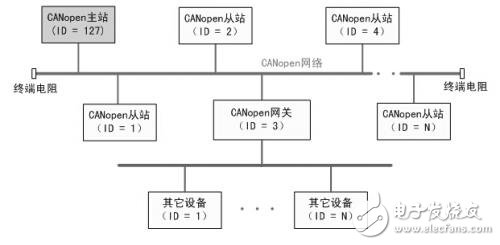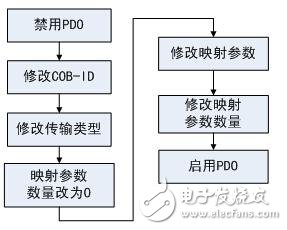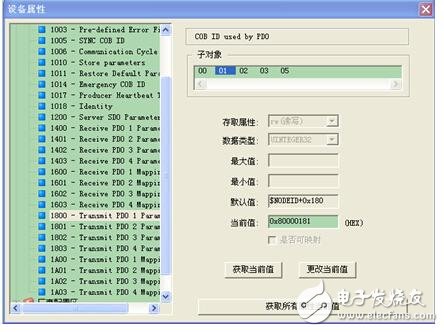The CANopen protocol has arisen in Europe. At present, almost all equipments in Europe, especially industrially developed Germany, provide CANopen support. China's industry is still relatively backward, and it is in the stage of introducing foreign advanced equipment. This requires us to understand CANopen communication. The protocol can also use CANopen devices to properly form a CANopen network for a specific application. CANopen's wide range of data transmission methods provide excellent solutions for a wide range of applications, commonly used in data acquisition and transmission, motor control, automotive electronics, battery charging control and textile industries.
1. CANopen slave / master station featuresDevices with Network Management (NMT) host functions are often referred to as CANopen master devices, and usually have Service Data Object (SDO) client functions. Conversely, a device with a network management (NMT) slave function is often referred to as a CANopen slave device, and it must have a service data server function. In this way, the CANopen master device can control the slave and read and write the object dictionary of the CANopen slave device.
(1) CANopen slave characteristics CANopen slave stations have unique node addresses in the CANopen network and can perform specific functions independently, such as data acquisition, motor control, and so on. Data with high real-time requirements is usually transmitted through a Process Data Object (PDO), so CANopen slaves should support a certain number of PDO transmission functions. According to the definition of CANopen protocol DS301 V4.02, each slave station has four TPDO (Transmit Process Data Object: TPDO) and four RPDO (Receive Process Data Object), and the slave station should also have node/lifetime. Protection or heartbeat messages and the production of emergency messages. Each CANopen slave should have an object dictionary that describes the application parameters and communication parameters that the slave has.
(2) CANopen master station characteristics The CANopen master station plays a different role from the CANopen slave station. Usually, the CANopen master station is responsible for network management, slave parameter configuration, and slave station data processing. Specific features, but also have their own object dictionary and unique node address.
2. CANopen network formationSince CANopen is an application layer protocol based on CAN bus, its network is built in accordance with the CAN bus. The typical bus type structure, the slave station and the master station are all connected to the bus. In a CANopen network, only There is one master device and several slave devices working at the same time. When using CANopen network cabling, shielded twisted pair cable is used to improve the bus anti-interference ability. Table 1 shows the relationship between the CAN communication baud rate and the bus length. Note that the length of the branch line of each node in the network is not too long. When the baud rate is greater than 100Kbps, the total length of the branch line should not be greater than 30m, and the branch line of a single node should not be greater than 60cm.

Table 1 bus length and baud rate relationship
(1) Basic CANopen network structure

Figure 1 CANopen basic network structure
Figure 1 shows the basic structure of a CANopen network. There is a CANopen master station in the network that manages all the slaves in the network. Each device has an independent node address (NodeID). Communication can also be established between the slave and the slave. It is usually necessary to configure each slave in advance so that independent slaves can establish independent PDO communication.
(2) Complex CANopen network structure

Figure 2 CANopen network with gateway device
Figure 3 shows a CANopen network with a gateway device. Compared to the basic CANopen network, a CANopen gateway device is added to the network. The gateway device can be CANopen to DeviceNet, Profibus, Modbus or other devices. In the CANopen network, we can also use the gateway device as a slave device or a CANopen master device.
3. Configuration of slaves in CANopen networkThe CANopen slave devices are factory-set with default parameters, and these parameters are tied to the node address, such as real-time data transfer PDO, whose predefined connection set defines its default parameters as 4 TPDOs and 4 RPDOs. Its COB-ID (Communica TIon Object - ID) is shown in Table 2. In some simple applications, only the default settings are required for normal communication. However, for some applications where complex applications are required, the slaves need to be configured accordingly. The most common configuration parameters are PDO COB-ID and PDO mapping. Parameters, parameters such as node/life protection.

Table 2 PDO predefined links
In the CANopen network, the parameter configuration or acquisition of the slave is transmitted via SDO, so both the slave and the master must support SDO transmission for normal configuration. In order to quickly configure the slave device, the entire network device is brought into the pre-operation state by the NMT before configuring the slave.
(1) Communication parameters The communication parameters of the CANopen device include the COB-ID of the PDO, the transmission type, the prohibition time, and the mapping parameters. The parameter configuration sequence is shown in Figure 3.

Figure 3 communication parameter configuration sequence
When configuring the communication parameters of PDO, first disable PDO communication. According to the definition of DS301 V4.02, when the highest bit (31st bit) of COB-ID is 1, the PDO communication can be disabled. 4 is shown. It should be noted that the corresponding transmission type, mapping parameters and COB-ID values ​​can only be changed if PDO is disabled, otherwise an error will occur if an attempt is made to change in any way.
(2) Configuration of other parameters In addition to communication-related parameters, CANopen devices have some security-related parameters, such as node/lifetime protection or heartbeat messages. According to the definition of DS301 V4.02, only one of the node/life protection or heartbeat messages can be used in the same CANopen slave. Node/life protection enables two-way protection, ie the master can monitor the status of the slave and the slave can also monitor whether the master is online. The heartbeat message is only a one-way protection mechanism. The consumer of the heartbeat message can monitor the status of the heartbeat message producer. In the case of a large network bus load, it is recommended to use the protection mechanism of the heartbeat message to reduce the bus load.

Figure 4 prohibits PDO communication method
Portable power stations, also known as battery powered inverter generators, are rechargeable units capable of dispensing power for charging devices. It is equipped with AC outlet and USB charging ports. Camping trips and power outages are best applications of these units. The global portable power station market size is set to reach USD 482 million by 2026, according to Market Research Future (MRFR). It can display 7.60% CAGR over the forecast period (2020-2026). Huge demand for alternatives to gas generators and need for units capable of running heavy applications can drive the majority of the market demand.
The market growth is attributed to rising use of smart electronic devices and huge requirement for uninterrupted power supply. Areas frequented by power outages caused by natural disasters are expected to be a lucrative market for portable power stations. Residents are shelling out for these generators for charging smartphones capable of calling emergency responders. Moreover, discounts and deals for portable power stations on ecommerce portals can drive the market volume significantly. The large opportunity for consumer electronic products owing to restrictions on movement during the pandemic can be leveraged by market players.
The long charging times and high costs of these generators can restrain market growth.
Best Wireless Power Bank,Wireless Power Bank For Iphone,Best Portable Battery Charger,Best Portable Charger
Shenzhen Sunbeam New Energy Co., Ltd , https://www.sunbeambattery.com